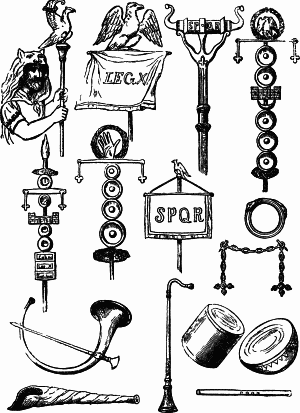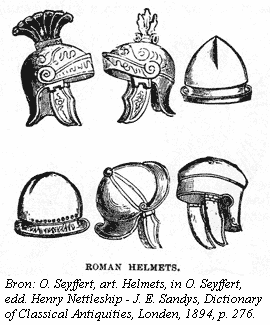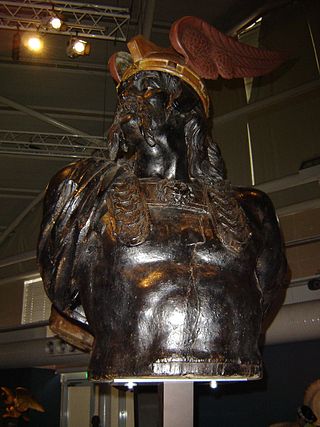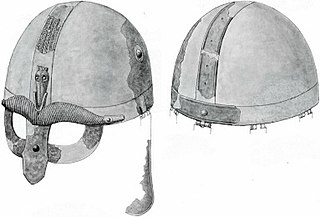Development
Although derived from a Celtic original, the Imperial helmet had more advanced features, such as a sloped neck guard with ribbing at the nape, projecting ear guards, brass trim, and decorative bosses.
The Roman combat experience of the Dacian wars produced further developments in helmet design, particularly the two iron bars riveted crosswise across the helmet skull (alternatively, two thick bronze strips might be riveted to the top of a bronze legionary or auxiliary helmet); it has been suggested that this form of reinforcement was added as protection against the falx.
This started as a field modification, as seen on several Imperial Gallic helmets with the crossbars hastily riveted right over the decorative eyebrows (crossbars are seen on some, though not all, of the legionary helmets on Trajan's Column), but quickly became a standard feature, found on all helmets produced from ca. AD 125 through the latter 3rd century AD.

The lorica segmentata, also called lorica lamminata, is a type of personal armour that was used by soldiers of the Roman army, consisting of metal strips fashioned into circular bands, fastened to internal leather straps. The lorica segmentata has come to be viewed as iconic of the Roman legions in popular culture. The tendency to portray Roman legionaries clad in this type of armour often extends to periods of time that are too early or too late in history.

Kabuto is a type of helmet first used by ancient Japanese warriors which, in later periods, became an important part of the traditional Japanese armour worn by the samurai class and their retainers in feudal Japan.

The falx was a weapon with a curved blade that was sharp on the inside edge used by the Thracians and Dacians. The name was later applied to a siege hook used by the Romans.

A manica or cheires by the Greeks was a type of iron or bronze arm guard, with curved and overlapping metal segments or plates, fastened to leather straps, worn by Roman gladiators called crupellarii, and later optionally by soldiers.

Roman military personal equipment was produced in large numbers to established patterns, and used in an established manner. These standard patterns and uses were called the res militaris or disciplina. Its regular practice during the Roman Republic and Roman Empire led to military excellence and victory. The equipment gave the Romans a very distinct advantage over their barbarian enemies, especially so in the case of armour. This does not mean that every Roman soldier had better equipment than the richer men among his opponents. According to Edward Luttwak, Roman equipment was not of a better quality than that used by the majority of Rome's adversaries. Other historians and writers have stated that the Roman army's need for large quantities of "mass produced" equipment after the Marian Reforms and subsequent civil wars led to a decline in the quality of Roman equipment compared to the earlier Republican era:
The production of these kinds of helmets of Italic tradition decreased in quality because of the demands of equipping huge armies, especially during civil wars...The bad quality of these helmets is recorded by the sources describing how sometimes they were covered by wicker protections, like those of Pompeius' soldiers during the siege of Dyrrachium in 48 BC, which were seriously damaged by the missiles of Caesar's slingers and archers.
It would appear that armour quality suffered at times when mass production methods were being used to meet the increased demand ..." and "...the reduced size curiasses would also have been quicker and cheaper to produce, which may have been a deciding factor at times of financial crisis, or where large bodies of men were required to be mobilized at short notice, possibly reflected in the poor-quality, mass produced iron helmets of Imperial Italic type C, as found, for example, in the River Po at Cremona, associated with the Civil Wars of AD 69 AD; Russell Robinson, 1975, 67
Up until then, the quality of helmets had been fairly consistent and the bowls well decorated and finished. However, after the Marian Reforms, with their resultant influx of the poorest citizens into the army, there must inevitably have been a massive demand for cheaper equipment, a situation which can only have been exacerbated by the Civil Wars...

A galea was a Roman soldier's helmet. Some gladiators, specifically myrmillones, also wore bronze galeae with face masks and decorations, often a fish on its crest. The exact form or design of the helmet varied significantly over time, between differing unit types, and also between individual examples – pre-industrial production was by hand – so it is not certain to what degree there was any standardization even under the Roman Empire.

A winged helmet is a helmet decorated with wings, usually on both sides. Ancient depictions of the god Hermes, Mercury and of Roma depict them wearing winged helmets, and in the 19th century the winged helmet became widely used to depict the Celts. It was also used in romantic illustrations of legendary Norse gods and heroes. The motif, along with the horned helmet, became a clichéd signifier of the Northern warrior.

The Montefortino helmet was a type of Celtic, and later Roman, military helmet used from around 300 BC through the 1st century AD with continuing modifications. This helmet type is named after the region of Montefortino in Italy, where a Montefortino helmet was first uncovered in a Celtic burial. The Montefortino helmet originated in the 4th century BCE and was influenced by Etruscan and Celtic helmets. The helmet was brought to Italy by the Senones and. It was the most popular helmet amongst the Roman army during the Republican period. The Montefortino helmet remained the most popular Roman helmet until the first century CE. Although in the Roman military it was replaced by the Coolus helmet, it continued to be used by the Praetorian guard.

The Coolus helmet was a type of ancient Celtic and Roman helmet popular in the 1st century BCE. It was typically made in bronze or brass and, like the Montefortino type with which it co-existed, was a descendant of Celtic helmet types. The explanation of the choice to use bronze can be attributed to the type of warfare that the helmet was used for; also the cultural affinities have influence on why the helmet was made the way that it was. Within a long process of evolution, Roman military armor for the head developed from early pre-Roman helmets. Rome itself had no proper tradition of such objects, as most of the soldiers of the Early Republic made use of helmets produced by the Etruscans, whose craftsmen were known for their ability to make vessels. The Canterbury helmet from England is an example.

The Coppergate Helmet is an eighth-century Anglo-Saxon helmet found in York, England. It was discovered in May 1982 during excavations for the Jorvik Viking Centre at the bottom of a pit that is thought to have once been a well.

The legions of the Roman Republic and Empire had a fairly standardised dress and armour, particularly from approximately the early to mid 1st century onward, when Lorica Segmentata was introduced. However the lack of unified production for the Roman army meant that there were still considerable differences in detail. Even the armour produced in state factories varied according to the province of origin.

The Roman army of the late Republic refers to the armed forces deployed by the late Roman Republic, from the beginning of the first century BC until the establishment of the Imperial Roman army by Augustus in 30 BC.

The appearance of Celts in Transylvania can be traced to the later La Tène period . Excavation of the great La Tène necropolis at Apahida, Cluj County, by S. Kovacs at the turn of the 20th century revealed the first evidence of Celtic culture in Romania. The 3rd–2nd century BC site is remarkable for its cremation burials and chiefly wheel-made funeral vessels.
The Canterbury Helmet is an Iron Age helmet found in a field near Canterbury, Kent, England, in December 2012. Made of bronze, it is one of only a few helmets dating from the Iron Age to ever have been found in Britain. The helmet currently resides in the British Museum, and is undergoing conservation work. It was found by Mr Trevor Rodgers, who found it together with an iron brooch and a pin, and it is thought to have contained a bag with cremated human remains.

The Agris Helmet is a ceremonial Celtic helmet from c. 350 BC that was found in a cave near Agris, Charente, France, in 1981. It is a masterpiece of Celtic art, and would probably have been used for display rather than worn in battle. The helmet consists of an iron cap completely covered with bands of bronze. The bronze is in turn covered with unusually pure gold leaf, with embedded coral decorations attached using silver rivets. One of the cheek guards was also found and has similar materials and designs. The helmet is mostly decorated in early Celtic patterns but there are later Celtic motifs and signs of Etruscan or Greek influence. The quality of the gold indicates that the helmet may well have been made locally in the Atlantic region.

The Emesa helmet is a Roman cavalry helmet from the early first century AD. It consists of an iron head piece and face mask, the latter of which is covered in a sheet of silver and presents the individualised portrait of a face, likely its owner. Decorations, some of which are gilded, adorn the head piece. Confiscated by Syrian police soon after looters discovered it amidst a complex of tombs in the modern-day city of Homs in 1936, eventually the helmet was restored thoroughly at the British Museum, and is now in the collection of the National Museum of Damascus. It has been exhibited internationally, although as of 2017, due to the Syrian civil war, the more valuable items owned by the National Museum are hidden in underground storage.

The Caetrati were a type of light infantry in ancient Iberia who often fought as skirmishers. They were armed with a caetra shield, swords, and javelins.

The Witcham Gravel helmet is a Roman auxiliary cavalry helmet from the first century AD. Only the decorative copper alloy casing remains; an iron core originally fit under the casing, but has now corroded away. The cap, neck guard, and cheek guards were originally tinned, giving the appearance of a silver helmet encircled by a gold band. The helmet's distinctive feature is the presence of three hollow bosses, out of an original six, that decorate the exterior. No other Roman helmet is known to have such a feature. They may be a decorative embellishment influenced by Etruscan helmets from the sixth century BC, which had similar, lead-filled bosses, that would have deflected blades.
Ross Cowan is a British historian and author specialising in Roman military history.

The Broe helmet is a decorated iron helmet from around the Vendel Period. Discovered around 1904 in a cremation grave in Broe, a farm on the Swedish island Gotland, it was located alongside other items including fragments of shields, weapons, bridles, and game pieces. Due to its extremely fragmented condition, only an incomplete reconstruction of the helmet is possible, but it appears to have been an example of the "crested helmets" that flourished in England and Scandinavia from the sixth through eleventh centuries.




















